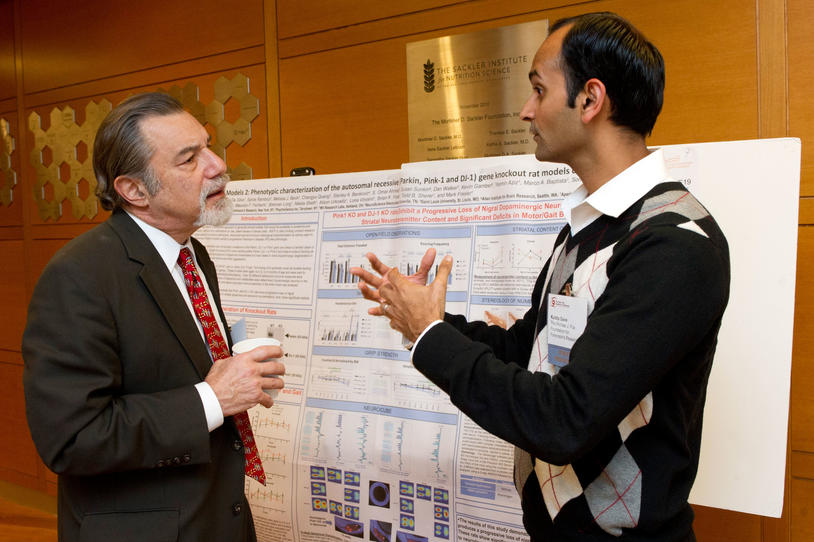
Says conference chair: ‘Today, we are thinking more globally than ever before’
This week, over 225 researchers from across the globe, more than half of them representing industry, gathered at the sixth annual Parkinson’s Disease (PD) Therapeutics Conference to hear presentations on a variety of novel approaches to PD drug development, and to discuss how academia and industry can work together to bring new treatments to market, faster.
Last year, PD Therapeutics Chair David Weiner, MD, recapped the conference by saying, “The word dopamine did not appear in any of the titles of the day’s talks. This is a very good step in the right direction.” His counterpart in 2012, Kalpana Merchant, PhD, referenced, and then echoed, his sentiment: “Today, we are thinking more globally about PD than just the dopaminergic system. In fact, we are thinking more globally than ever before about how to develop new and better Parkinson’s treatments.”
Thinking globally, and alternatively, is critical in a current drug development climate that is broken. On average, the time it takes to bring one new drug to market is 15-30 years, with a cost of $1 billion. And this is for those few compounds that actually make it to pharmacy shelves. Most potential treatments die early, often falling prey to what Michael J. Fox Foundation (MJFF) Co-Founder Debi Brooks calls “the Valley of Death,” that period of research when an idea born in a university or biotech loses steam, and is unable to secure the necessary support from the pharmaceutical industry to move research from the laboratory and into the clinic.
New drug targets, in particular, are often viewed as too risky for investment. A sobering statistic shared by Stephen Hitchcock, PhD, of Envoy Therapeutics, and a speaker at this year’s conference, drives this point home: “Only four new central nervous system targets have been drugged in the past 15 years.”
The good news is PD Therapeutics offers attendees from universities a much needed opportunity to network with those from Big Pharma who have the resources to bring novel targets across this “Valley of Death,” and closer to pharmacy shelves. It also offers representatives from such companies a rare view of the landscape of potential Parkinson’s drugs.
“It will take the shared vision and resources of a community like the one assembled at PD Therapeutics to discover and develop new therapies for Parkinson’s disease,” said Eli Lilly’s Merchant.
“What a way to spend the day. I won’t be able to sleep tonight, there’s way too much food for thought.”
PD Therapeutics 2012 was presented by MJFF and the New York Academy of Sciences. Event sponsors included UCB, Orion, Merck, Adamas, BIO and BioFocus.
Read on to find out about a few of the new projects that were discussed at this year’s event.
mGluR5 to treat dyskinesia
Charlotte Keywood, MBBS MRCP FFPM, of Addex Therapeutics, presented positive results from an MJFF-funded phase 2 clinical study of their drug candidate dipraglurant, which is being tested as a therapy to be taken in conjunction with levodopa, the gold standard Parkinson’s drug which can sometimes lead to dyskinesia. The hope is that dipraglurant, which targets the brain’s glutamate system, would allow patients to experience the benefits of levodopa while limiting this disabling side effect.
Serotonin to treat dyskinesia
Emer Leahy, PhD, of biotech PsychoGenics, spoke on a trial into eltoprazine, a drug which has shown promising pre-clinical results targeting neurons in the brain that produce a neurotransmitter called serotonin. Researchers think that serotonin neurons may play a role in causing dyskinesia.
Alpha-synuclein as disease-modifying treatment
Jeffry Stock, PhD, of Signum Biosiences explained how his company is targeting a certain cellular process that they believe leads to the clumping of alpha-synuclein in the brains of people with PD. By enhancing the activity of a protein called PP2A, researchers hope they might be able to prevent this clumping. In fact, Stock believes that a particular compound found in coffee might help to enhance PP2A activity, and researchers have begun to study doses of a decaffeinated brew for its effects in preventing this alpha-synuclein aggregation. Signum has also entered into a development deal with GlaxoSmithKline to screen and identify potential PP2A-targeted compounds.